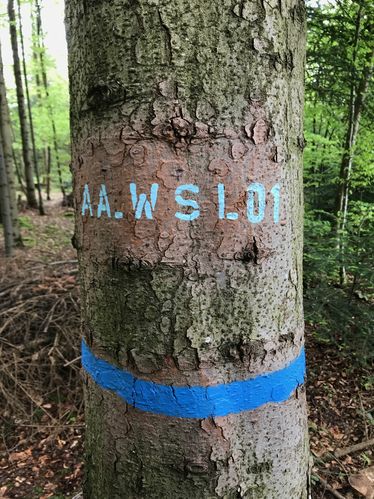
BCN, 20 June, 2019.- «AA_WSL01» is written in blue on an inconspicuous fir tree in the «Rameren» forest in Birmensdorf near Zurich. The DNA for the first sequenced silver fir genome – the complete genetic material – was obtained from its seeds and needles. Worldwide, silver fir is only the sixth conifer species whose genome sequence is known – which was quite a challenge as coniferous trees have an extremely large genome with many repeating, similar stretches of DNA sequence.
For this reason, this major task of sequencing it was only possible thanks to international cooperation. The CNAG-CRG Genome Assembly and Annotation team led by Tyler Alioto decoded a total of 18 billion base pairs, the individual building blocks of DNA. That's six times more than in the human genome.
"It's like a huge puzzle that you put together without a template", explains co-author Felix Gugerli of the Swiss Research Institute (WSL). "We now have a comprehensive but slightly blurred picture of the silver fir genome." The parts of the genome that contain genes– that is, genetic information for the production of proteins with specific functions — are now well described. Between these parts, however, there are many repetitive sequences of base pairs. Much work still needs to be done by the researchers in order to arrange a complete picture from these pieces of the puzzle.
The first sequenced silver fir stands in a forest in Birmensdorf near Zurich
and is a rather inconspicuous representative of its species.
(Photo: Christian Rellstab/WSL)
The right fir for every location
The effort is worthwhile, because a decoded genome helps to understand the genetic diversity within the species, for example, to describe which trees thrive particularly well at which sites. In addition, Christmas tree growers have an interest in selecting trees with desirable characteristics, such as long-lasting needles. Examining the genes of young plants makes it possible to establish their characteristics, so it is not necessary to wait until they have grown for several years. This is much quicker than carrying out costly planting trials.
Silver fir became popular in the 18th century as the Christmas tree par excellence until it was replaced by the longer-lasting Nordmann fir. As a result of climate change, silver fir is becoming increasingly important in silviculture as a substitute for the economically important spruce and beech. These species are less likely to thrive in a warmer and drier climate than fir. Compared to them, silver fir has been at a disadvantage because deer find its young shoots exceptionally tasty. As the deer population has been rapidly increasing due to a lack of natural enemies, these trees must often be protected by fences or plastic enclosures.
The expensive and time-consuming cultivation of the silver fir is more worthwhile when foresters can select the optimal trees for the planned location thanks to genomic analyses. Indeed, forest management is already directing its practice towards converting even age spruce forests back to uneven aged mixed spruce, fir, beech forest. Thus, the decoding of the silver fir's giga-genome is an investment into the future of an important tree species and in sustainable forest management.
Work of reference: A Reference Genome Sequence for the European Silver Fir (Abies alba Mill.): A Community-Generated Genomic Resource Elena Mosca, Fernando Cruz, Jèssica Gómez-Garrido, Luca Bianco, Christian Rellstab, Sabine Brodbeck, Katalin Csilléry, Bruno Fady, Matthias Fladung, Barbara Fussi, Dušan Gömöry, Santiago C. González-Martínez, Delphine Grivet, Marta Gut, Ole Kim Hansen, Katrin Heer, Zeki Kaya, Konstantin V. Krutovsky, Birgit Kersten, Sascha Liepelt, Lars Opgenoorth, Christoph Sperisen, Kristian K. Ullrich, Giovanni G. Vendramin, Marjana Westergren, Birgit Ziegenhagen, Tyler Alioto, Felix Gugerli, Berthold Heinze, Maria Höhn, Michela Troggio and David B. Neale. G3: Genes, Genomes, Genetics Early online June 19, 2019; https://doi.org/10.1534/g3.119.400083












